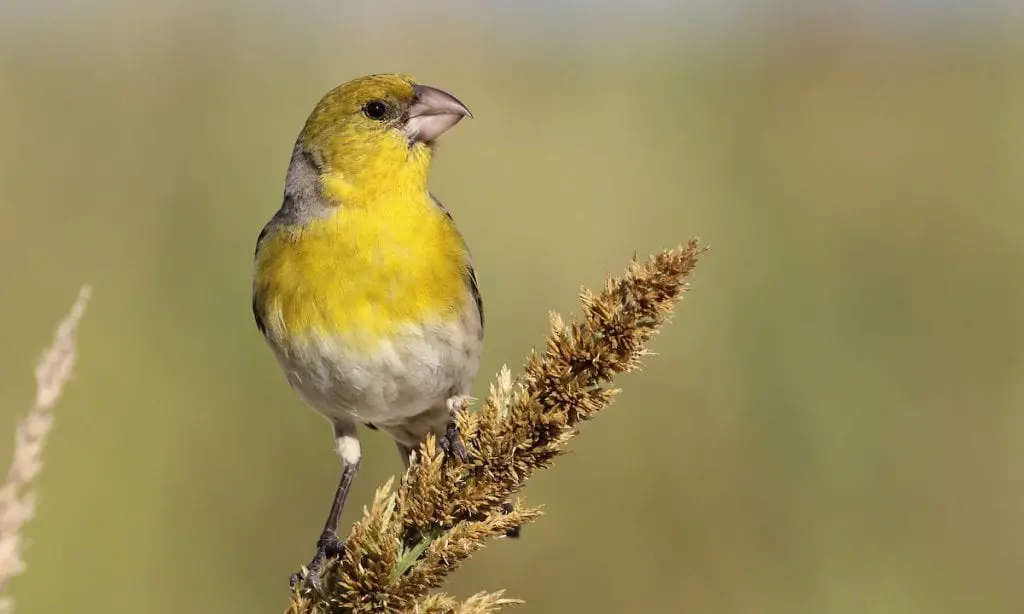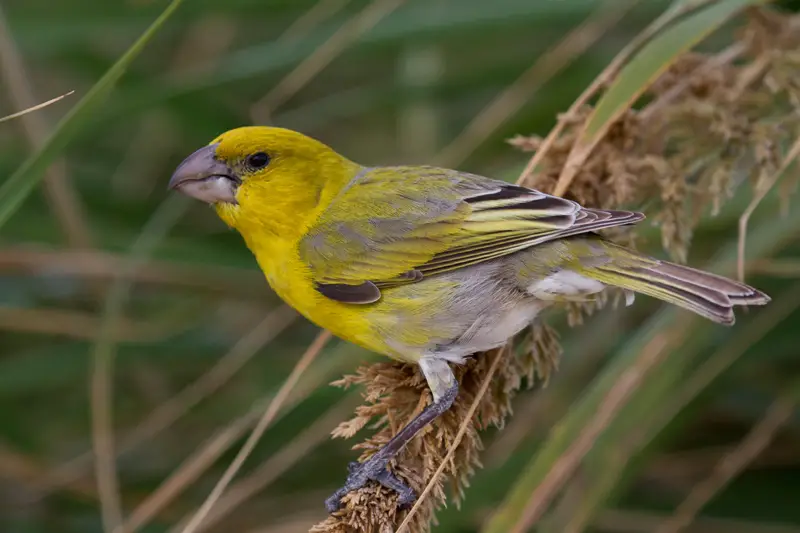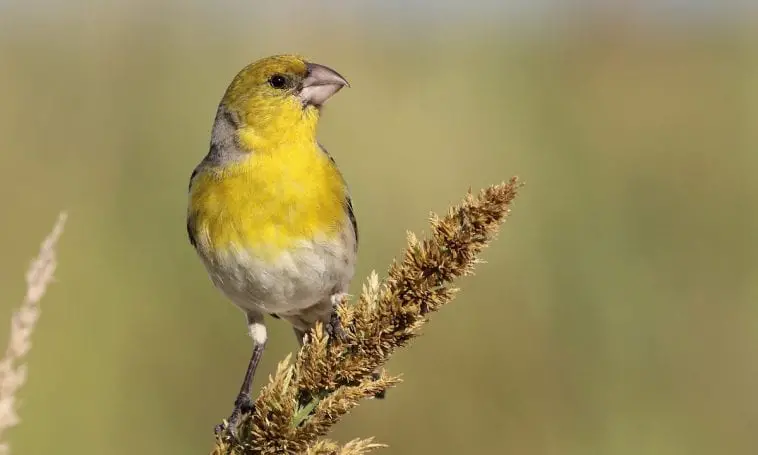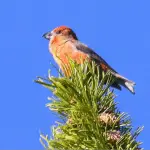Scientific Facts
| Scientific name | Telespiza cantans |
| Mass | 33 g (Adult) |
| Phylum | Chordata |
| Order | Passerine |

Description
The Laysan finch is a big honeycreeper with a weighty bill. General, the male, has creamy fluff with a whitish stomach and a grey neck. The female is cloudier than the male, with russet streaking. It is nearly impossible to complicate the Laysan finch with any further bird in the turf as it is the only passerine type found on the limited islands it survives on.
Range
On it finding the Laysan finch was a widespread dweller of the small isle of Laysan, along with the Laysan rail (Porzana palmeri), the Laysan honeycreeper (Himatione fraithii), the Laysan duck (Anas laysanensis), besides the Laysan millerbird (Acrocephalus familiaris familiaris). Inhabitants were presented to numerous islands, counting Pearl and Hermes Atoll, where the type continues, and Midway Atoll, where it endured until the overview of rats. The relic record displays that the finch once had a better variety in Hawaiʻi, reaching as distant as Oʻahu and that birds on Laysan signify a relict populace.
Behavior
The Laysan finch displays little terror of individuals and is easily trapped. Because of its harmonious song, it was measured as a decent cage bird by early travelers. It fodders on both vegetable and animal substances, counting seeds, tender sprouts of plants, florae, and the offspring of other birds.
Laysan finches are identified to feedstuff on a varied assortment of herbal and animal substantial. They will take kernels, tender sprouts of scrubs and grasses, floras, particularly those of Tribulus (Nohu) and Eragrostis, and offspring of numerous types of birds. The occurrence of predation on seabird offspring may be connected to the occurrence of humans on the isle who reason nesting seabirds to provisionally even from their nests. They are likewise recognized to fodder on deceased seabirds for the developing fly larvae or for additional invertebrates.
Eggs might be placed as primary as February or March, nonetheless most egg-laying happens from late-night April to initial June. The clutch scope is generally three eggs, nonetheless choices from two to four. Furthermost, nesting now befalls in bunches of bunchgrass, though older intelligence proposes these birds used additional nesting locations such as hovels in rocky parts and even constructions (which were previously contemporary on Laysan Island). Though, since Eragrostis has to turn out to be much more mutual, they seemingly now use lone bunches of this bunchgrass as nest locations.
The nest is a low cup completed of dead sward blades and rootlets. The limited nests (7) that were restrained by Richard S. Crossin in 1960 be around roughly 5.4 in (13.7 cm) crossways besides 2.7 in (6.9 cm) high. They have typically situated several inches or centimeters overhead the ground, positioned in a grass cluster and well covered.
Based on partial explanations of a few confined birds, development takes around 16 days, and the nestling period continues around another 15 days. The top of nesting seems to be in mid-spring through nesting has been pragmatic as initial as February. Most fledgling has fledged by late July or initial August. There is no information on a number of young positively fledged per nest.
Conservation
The Laysan finch is registered as Vulnerable by the IUCN since of its highly limited variety and susceptibility to extremes of climate, and it is careful threatened by the State of Hawaiʻi and U.S. government. It endured the overwhelming effects of the overview of domestic rabbits (dissimilar the Laysan millerbird, honeycreeper in addition rail) by captivating carrion and seabird offspring. Laysan is now a portion of the Hawaiian Islands National Wildlife Refuge. The populace is measured stable, with the main threat being irrepressible climate alteration.
Habitat
Laysan Island is in the northwestern Hawaiian Islands, a chain spreading from Nihoa Island, 250 mi (402.3 km) northwest of Oahu, to Kure Atoll, to in excess of 1,000 mi (1,609.3 km) to the northwest. Laysan is a minor coral isle of around 2 sq mi (5.2 sq km), ringed with sandbanks. The supreme promotion is 56 ft (17.1 m). A salt-water inlet is situated in the inner above an aged volcanic crater.
Distribution
Seemingly, this type of finch is modified to Laysan Island and neighboring reefs. Initial explorers labeled the finch as “exceptionally common,” and rough populace approximations in the early 1900s reached amid 2,700 and 4,000 birds. Rabbits were presented in 1903 and almost stripped the island of flora, causing a fast weakening in finches. By 1923 approximations suggested that only around 100 finches continued. The Laysan finch was positively introduced on East Island (Midway) in 1891 nonetheless vanished after rats became recognized there in 1943.
Nowadays, the Laysan finch is found in all the stagnated parts on the island. A separate populace, well-known on Pearl and Hermes Reef, has a feast from there to neighboring small islands. The entire Laysan finch populace is around 15,600 birds.
The Laysan finch needs dense flora for nesting and scavenging, characteristically shrubs, and floor-covering plants, for example, the herb Nama sandwichensis and the bush Scaevola. It favoritisms bunchgrass (E. variabilis ) for nesting.
Threats
After rabbits were detached from Laysan in 1923, flora reclaimed around half the island, inspiring retrieval of the Laysan finch populace. Other threats endure, though. The Laysan finch is highly vulnerable to avian illnesses, which are a continuous threat to such a delicate island bionetwork. The Laysan finch populace is currently checked for signs of illness.
Any natural tragedy, for example, a severe hurricane or a tidal wave, could abolish a big part of the populace and perhaps has from time to time in the previous. The outline of finch inhabitants to other isles has provided some amount of insurance in contradiction of death from a natural tragedy.
Fun Facts
The tune of the Laysan Finch has been labeled as “canary-like,” for this aim, it is occasionally called the Laysan Canary.
They are likewise frequently called Hawaiian Finches, a designation that, while ancient, now more carefully reproduces their recent organization as Fringilidae by the AOU.
Rabbits were presented to Laysan Island in 1903; they consumed the flora causing the statistics of this fowl to drop to about 100; other widespread species became nonexistent. These birds lived the lean periods by eating seed and deceased birds.
A cluster of honeycreepers is together recognized as a “hive” of honeycreepers.
Common Health Issues in Laysan Finch
Avian Flu
More than a few years before, cases of avian flu completed the newsflash around the world, and lately, they have once more been exploding up in the captions. Though most of the cases attentive on containing birds that are raised as nourishment, pet bird owners must distinguish that avian flu can affect natures of any type—a connotation that parrots and other normally kept pet birds are likewise at danger of contracting it if unprotected. While the danger of contact to captive pets is measured minimal, there are things that can be completed to additional defend your feathered buddy from this lethal pathogen.
Parasites
Parasites can distress any animal, counting birds and humans. It is significant to screen your pet birdie for any signs of internal or external pest invasions as children, other domesticated animals, and other domestic members can also bond them if unprotected. Certain parasites can be lethal to pet birds if not treated rapidly, so learning as abundant as you can regarding their signs, indications, and dangers of exposure is domineering to shielding your pet and family.
Psittacine Beak and Feather Disease (PBFD)
One health issue that strikes terror into the hearts of fowl owners is Psittacine Beak and Feather Disease, likewise recognized as “PBFD.” It is a lethal virus that reasons irregular beak and feather development, cuts, and various added problems. PBFD can distress any parrot types, and there is presently no known handling or cure. To make stuff worse, PBFD is highly transmissible and can rapidly spread through a complete flock of birds who are reserved in close lodgings. It is significant to learn regarding the signs of PBFD in order to stop the spread of this overwhelming disease to other birds that might be owned by you or your families and personal.
Egg Binding
Those who own masculine birds can breathe relaxed here—egg binding is a disorder that can only distress female birds of the breeding stage. Egg binding is a very grave problem and can reason demise in affected birds if it is not punctually treated by a skilled avian vet, so it is significant for folks who own female birds to turn out to be acquainted with the signs and indications of egg binding so that they can know any problems initial sufficient to save their pets.
Stress
Pretty abundant every adult animated distinguishes what pressure is, but numerous don’t understand that pressure can also distress parrots and other domesticated birds, and fair as it does in persons, it can reason a weakening in immune reply and make a bird more vulnerable to other diseases. While they are understated, there are more than a few dissimilar signs that fowl owners can watch for, consequently, that they can classify pressure in their birds and stop the start of more grave issues. It’s significant to study what can reason pressure in your feathered buddy and what you can do to opposite it if it has developed a problem.
Proventricular Dilatation Disease (PDD)
Proventricular Dilatation Disease (PDD) is one of the furthermost confusing avian disorders. The illness marks the nerves that source the bird’s stomach tract, though it can likewise distress nerves that source other organs, as well.
PDD is also recognized as Macaw Wasting Syndrome and Parrot Wasting Syndrome since it’s most normally identified in Macaws, African grey parrots, Amazon parrots, cockatoos, besides conures.
Indications of PDD comprise weight loss, nausea, vicissitudes in the bird’s mucks, and a distended crop, which is the brawny pouch near the gullet. Though, no one sign or indication can differentiate PPD. Some birds might not display any signs of disease until they are very sick with the ailment.
Treatment will frequently be nonsteroidal anti-inflammatory drugs (NSAIDs), and the fowl might have to be placed on a singular diet. Though there’s no treatment for the illness, so these handlings are just to decrease discomfort for the rest of the birds’ existence.
Psittacosis (Parrot Fever)
Psittacosis, or “Parrot Fever,” is a method of the Chlamydia bacterium that can distress all hookbills. The illness is highly transmissible and can be passed from nature to animals, in addition to humans.
Indications of Psittacosis aren’t exact, but they comprise trouble in breathing, eye contagions, and irritation, as well as loose, wet muck and general weariness. Treatment is greatest frequently an antibiotic, tetracycline, which can be specified orally or through inoculations. Though, birds taking tetracycline cannot consume calcium since of its effect on medicine.
Polyomavirus
Polyomavirus is a complaint that distresses caged birds, chiefly parrots. Birds that are newborn or adolescents are most at danger, and the illness is typically deadly.
Indications of polyomavirus comprise hunger loss, an enlarged stomach, paralysis, then diarrhea. Some birds might not display outward indications at all, nonetheless are transporters of the disease and might shed it in times of pressure, posing a danger of contagion to other birds in the household.
There is no recognized action for polyomavirus. This illness can grow rapidly and has a high death rate.
Candida
Candida, or Candidiasis, is a fungiform contagion that can mark the peptic tract of all types of birds. The illness includes an overgrowth of yeasts that are generally found in a bird’s peptic system.
Common indications of Candida contagions include white cuts in and around the opening and gullet, nausea, appetite loss, and a yield that is slow to unfill. The bird might seem to be sluggish.
Most Candida contagions are positively treated by means of antifungal medicines. Candida often grows secondary to additional illness, so the bird should be inspected and treated for all possible difficulties by a vet.

Care Sheet
No Bird Is an Isle
Before presenting a new birdie, take him or her to an avian vet for an examination. If the novice is fit and free of illnesses, placed his or her birdcage inside or next to the greater flight inclusion, consequently, that the birds can understand each other deprived of coming into straight interaction with one another. Watch to understand in what way the birds get by for at least one week. If they appear welcoming to each other, let the birds call—oversaw—using distinct play stands. Once you are self-assured that the bird’s stance no danger to one another, open the entrance of the small birdcage. The novice will come out once he or she feels contented enough.
Consent this birdcage in place; door exposed, so the novice might use it as a harmless place—the occupant bird must also have a big flight birdcage of his or her own to usage as a private area. Until you’re unconditionally certain that the birds have attached, do not leave them alone composed. Don’t shoulder that these 2 birds will certainly become friends—be ready to house the birds distinctly if they do not tie.
Birds Can’t Animate on Kernels Alone
Rough birds don’t consume just kernels, so retain your bird’s régime diverse and nourishing by offering a diversity of fruits and vegetables along with smidgens, nuts, cooked beans, and kernels. Diverse species have dissimilar nutritious needs, so it’s authoritative to investigate your bird’s food or refer with an avian veterinarian. Malnutrition accounts for in excess of 90 percent of the health difficulties of friend birds.
Birds want the proper mixture of vitamins, minerals, besides amino acids to stay well. Good pellet-based food can aid, but nourishing the diversity of the proper nourishments should meet all your birds’ requirements.
Retain nourishment and water ampules above roosts, so they do not get grubby with mucks. Soiled ampules must be prepared instantly. Some birds dip their food in liquid, and those water vessels should be prepared as a minimum twice a day to stop bacterial development. Vitamins must never be directed through the liquid.
Never give gravel to a parrot. Gravel has no dwelling in a parrot’s food—it can mineralize in the gizzard and reason tender crop impactions. Sand is only essential in the food of birds who eat kernels whole, for example, canaries and doves.
Time to Groom
Your birds might devote hours every day, scrutinizing their fluffs with their beaks. This helps retain their fluffs in line and water-resistant. To inspire preening, deliver shallow ampules or a birdbath full of water. Some birds like to be mist over with water from a spray flask set to a fine haze. After your bird’s bathe, save them away from breezes until their fluffs are completely dry.
Beak trims must not be desirable, except there is a fundamental health problem. Overgrown spikes or beaks need a trip to a decent avian veterinarian.
Bird-Proofing Your ‘Nest’
Beforehand allowing your feathered friend to fly free, remove or shelter up dangers like ceiling fans, vessels of water, exposed toilet bowls, electrical ropes, large glass gaps and mirrors, and places where birds could convert wedged. Make certain that your vegetations are not toxic to birds. Common vegetations that are poisonous if birds eat them comprise English ivy, philodendron, azaleas, besides holly. A decent avian veterinarian can deliver you with a wide list.
Birds have very delicate respiratory systems. Inflamed nonstick cookware besides self-cleaning ovens produce vapors that are lethal to birds—never usage them in a household with birds. Use environmentally safe crops—no bleach or robust detergents, aerosols, artificial air fresheners, perfumed candles, incense, or pesticides. Cigarette smoke must never be allowable around birds. If your room complex stresses that you make your room obtainable to an exterminator, you can lawfully refuse health details.
If you or persons you know previously have birds and are powerless to meet their requirements, please reflect the following choices:
Discover if there is a trustworthy bird preserve or big indoor/outside aviary (or an outside one in very warm weather) to which you can submit the bird. Preferably, you must place non-violent birds with affiliates of their own class or family. Reflect the climate, chances for socialization and confidentiality, and other important issues such as food, exercise and enrichment chances, hygiene, and admission to veterinary care.
If you cannot locate a reputable sanctuary, reflect placing the bird with somebody who has additional birds of the similar species, lets them animate in a free-flight state, and will never distinct them as soon as they have attached. Also, make certain that they used a board-specialized avian veterinarian and do not breed natures.
Availability and where to get one
There are specialized pet shops where you could get such kind of bird. It will also help to ask for recommendations and referrals from your local avian doctor as well as a professional bird breeder.
FAQ Section
Can you get ill from birds?
Signs in fowls: Birds do not get ill from histoplasmosis. … Individuals most usually get psittacosis afterwards contact to domesticated birds, such as parrots and cockatiels, besides poultry, like turkeys or ducks. After birds are diseased, veterinarians call the illness avian chlamydiosis.
Do dead birds carry illnesses?
A bird’s plumage, chiefly from those living in an urban setting, can frequently play host to a variety of parasites, microorganisms, and diseases. However, it is chiefly the fluffs of a dead bird that transmit said illnesses. It’s significant to note that the odds of catching an illness from bird fluffs are very slim.
What are finches recognized for?
The true finches are branded by their stout, tapering bills, used to blow open the kernels that form the bulk of their diet. They are appreciated as slayers of weed kernels; countless also eat damaging insects. … Other types normally called finches, particularly many classes kept as companions, are likewise found in other bird relations.
Are finches tough to take care of?
Finches are countless companions for eventful people. They favor their own company and don’t want a lot of courtesy. They do want proper maintenance, however, and they are vulnerable to a host of fitness problems. Birds hide their diseases well, and by the time you see your bird is ill, it will be tough to treat.



